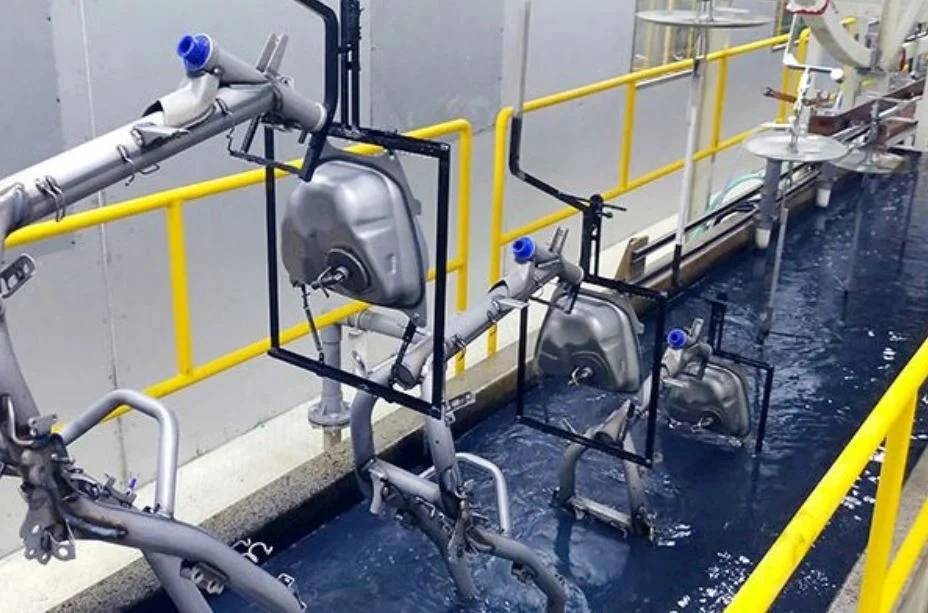This comprehensive guide delves deep into the workings, benefits, and critical aspects of an Aluminum Products E-Coating Line, explaining why it's an indispensable solution for high-quality aluminum finishing.
1. Understanding the E-Coating Process for Aluminum
At its core, an Aluminum Products E-Coating Line utilizes the principles of electrolysis to deposit a protective and decorative polymer coating onto aluminum substrates. The process involves immersing the aluminum parts in a water-based paint bath containing charged resin particles. An electrical current is applied, with the parts acting as one electrode (typically the cathode in cathodic e-coat systems, most common for corrosion protection). This electrical field causes the oppositely charged paint particles to migrate uniformly towards and deposit onto all conductive surfaces of the aluminum part.
The key characteristic of e-coating, especially within an Aluminum Products E-Coating Line, is its exceptional throwing power. This means the coating penetrates deep into recesses, covers sharp edges uniformly, and coats complex geometries completely – areas notoriously difficult to cover evenly with spray methods. The result is a consistent, continuous film that provides a robust barrier against corrosion, chemicals, and abrasion. The process is highly automated and controllable, ensuring consistent quality part after part.
2. The Critical Stages of an Aluminum Products E-Coating Line
A modern Aluminum Products E-Coating Line is a multi-stage, precisely engineered sequence. Each stage is vital to achieving the final quality and performance:
Pre-Cleaning & Degreasing: Removal of oils, greases, drawing compounds, and other gross soils using alkaline cleaners. Essential for adhesion.
Rinsing (Multiple Stages): Thorough rinsing with DI (Deionized) water to remove cleaning residues and prevent contamination carryover.
Surface Conversion Coating (Pretreatment): This is arguably the MOST critical step for aluminum. Processes like Chromium-Free (e.g., zirconium, titanium-based) or Trivalent Chromium Conversion create a microcrystalline layer that dramatically enhances e-coat adhesion and provides additional corrosion resistance at the metal interface. This step is tailored specifically for aluminum alloys.
Final Rinse & DI Rinse: Ensures all pretreatment chemicals are completely removed before entering the e-coat bath.
Electrodeposition (E-Coat Bath): The aluminum parts are immersed in the e-coat tank. Voltage is applied for a controlled time, depositing the paint film. Film thickness is precisely managed by voltage and immersion time.
Post Rinses (Ultrafiltration Rinses): Utilize permeate from the bath's ultrafiltration system to reclaim excess coating material, improving efficiency and minimizing waste.
Drain & Entry to Oven: Parts are allowed to drain to minimize dragout before curing.
Curing (Baking): Parts pass through a multi-zone oven where the deposited film cross-links (cures) at specific temperatures (typically 160-185°C / 320-365°F) to achieve its final hardness, adhesion, and chemical resistance properties. Precise temperature control is vital.
Cooling: Parts are cooled before handling or further processing.
3. Essential Equipment in an Aluminum Products E-Coating Line
The efficiency and effectiveness of an Aluminum Products E-Coating Line depend on its core equipment:
Material Handling System: Robust conveyors (overhead, power-and-free) designed to transport racks or fixtures holding aluminum parts reliably through all stages without damage.
Tanks: Constructed from corrosion-resistant materials (stainless steel, lined steel, polypropylene) for cleaners, rinses, pretreatment, and the main e-coat bath.
Rectifiers: High-precision DC power supplies that provide the controlled voltage/amperage for the electrodeposition process.
E-Coat Bath Circulation System: Includes pumps, filters, heat exchangers (for temperature control), and agitation to maintain bath homogeneity, prevent settling, and ensure consistent deposition.
Ultrafiltration (UF) System: A membrane filtration unit integral to the Aluminum Products E-Coating Line. It separates water and low molecular weight components from the bath, producing permeate for post-rinses. This conserves paint solids, controls bath contamination, and improves rinse efficiency.


